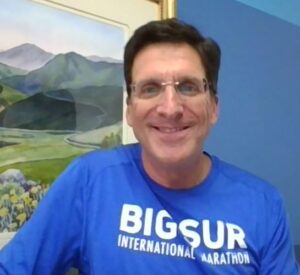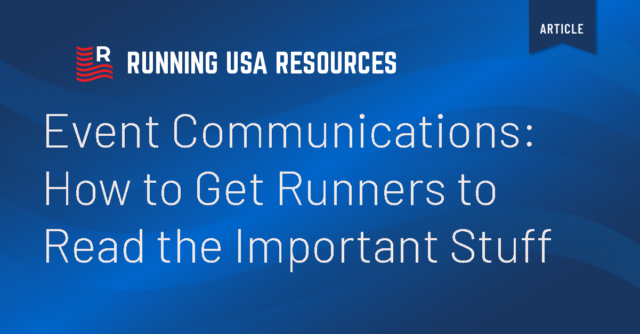By Doug Thurston
One of the most common challenges for many race directors is finding the best way to share important race details with participants. Race committees put in months of planning for the event and they want entrants to have a great experience. But every race is different and helping runners navigate the details of yours takes careful planning.
Before email and websites, it was common for the paper race entry form to include most of the details needed to register and participate. It often took hours of painstaking writing and editing to get the details on a paper brochure suitable for bulk mailing. For larger races, sometimes the entry form was a multi-page pamphlet or small book.
These days, of course, almost all race information is provided digitally on the website, entry path, confirmation, final instructions, and—more and more often—on QR codes at the expo and on the mobile race app.
As someone with both a journalism background and 40-plus years of race directing, here are a few ideas about keeping your runners informed.
Step one is to put together a complete race communication plan from recruiting entrants through race weekend to the post-race results and information about the next event. Items in your plan should include the basic journalism checklist of who, what, when, where, how and why. For example,
• Why should someone enter your event?
• What is the history of the race? What makes it worth their time and money? What can they expect to receive?
• Who can enter? Are there restrictions, entry caps, qualifications, or other requirements or rules? Who does it benefit?
• How can they enter? How much is it?
• Where is the race? How will they get there?
There are scores of answers to these and other questions. Brainstorm with your race committee and always consider the perspective of someone entering their very first race. Sure, an experienced runner who has done hundreds of races will skip over most of this, but many first-timers will pour over the details, rereading them over and over.
Establish a tone, theme, or “voice” to your communications. Some use humor or are folksy: I remember a race director in North Carolina, I believe, who years ago started off his race instructions with, “Read These or You Will Surely Die.” It sure caught the attention of his runners! Others hide little “cookies” in the information, like a funny or ironic comment, to see who is reading it carefully. Other presentations may come off as more corporate. Do what feels right for your race and your communications director.
Consider having an outside proofreader or passing important information by a “test audience” of a handful of people who are not connected to the race. Ask them if the information is logical, easy to follow, and enjoyable to read. Sometimes we get too close to our events and assume folks understand common race terms and phrases. Someone who is doing the race for the first time may have no idea what we mean by gear check, start corrals, pace groups, and that, yes, there will be bathrooms at the start and on the course, etc. And, of course, be careful with punctuation and grammar, be consistent with tense, update your use of pronouns, etc.
A skilled graphic artist can increase readability of copy-dense instructions using color, lists, copy blocks, call-outs or boxed sidebars, photos, etc. There might be thousands of words in your race instructions, for example, but they can be presented in readable sections for easier navigation. Consider a “Top 10” list to highlight the most important things you want everyone to know before you get into the details.
Other races have good luck sending out a series of instructional emails with different topics like pre-race day (expo, parking, bib pick-up, merchandise, clinics, carbo dinner, etc.); race-morning (transportation, gear-check, start times); running the race (aid stations, mile markers, pace groups, course details, entertainment); finish line (timing, gear check, food, family reunion); and post-race (awards, entertainment, shuttles, lost-and-found, results, on-site merchandise, registration for next year).
The Houston Marathon prints race-day details on the large envelope used to hand-out race bibs and safety pins. This creative approach assures folks have important details literally in their hand a day or two before the race.
Make sure your race website is accurate and up to date with the same information you are sending out to participants. Post links to instructions on social media. It’s fine to repeat important items in race communications for reinforcement.
Speaking of social media, if you don’t already have one, consider creating a Facebook “Fan Page” for entrants to interact with each other and get insider tips from experienced runners, etc. This can be done officially through the race or outside the race by a “superfan.” If the page is not created and monitored by your race staff and team, it’s a good idea to review posts often to make sure information being shared is accurate.
Review the websites of other races, both in your area and some of the larger, national races. You will likely find many examples of best practices and can even note how the information posted on their sites change as race-day approaches.
Race-weekend and even race-morning notifications via Twitter, Instagram, Facebook, text, or email can help remind runners of important about race details and can also clarify any security or COVID protocols in place at the race.
A well-staffed information booth at the expo and race day can help answer the many last-minute questions—as well as make it painfully obvious which runners didn’t read any of the information they were sent! Realistically, though, we know that folks process information differently and some just want verbal or written reassurance that they understand what’s expected of them and what is going to happen race day.
Good luck developing and implementing your communications plan and please reach out to your fellow race directors for examples and advice.

Doug Thurston has been directing races since the early 1980’s, most recently with the Big Sur Marathon Foundation in California, and continues to consult with events large and small across the country. He can be reached at tallrunnerdoug@gmail.com.

